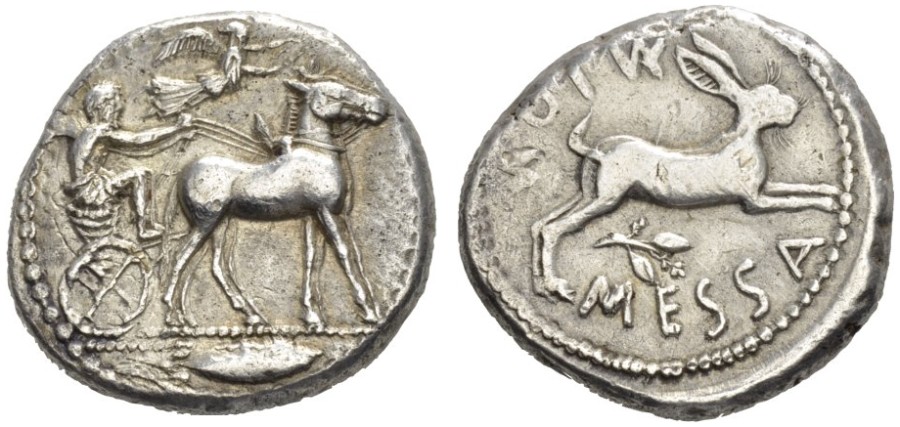AC 66 - Messana, silver, tetradrachms (460-426 BCE)
From SILVER
460 BCE - 426 BCE Silver 20,338 kg
Description
| ObverseInscription or printing placed on the obverse.: | Mule biga driven r. by charioteer, above, Nike flying r. and below, bay leaf. |
| ReverseInscription or printing placed on the reverse.: | MESSENION or MESSANION (Greek).Hare springing r., below, branch. |
Mint and issuing power
| MintIdentifies the place of manufacture or issue of a numismatic object.: | Messana | Ancient regionAncient region.: | Sicily | Modern countryModern country: Italy | AuthorityIdentifies the issuing power. The authority can be "pretended" when the name or the portrait of X is on the coin but he/she was not the issuing power. It can also be "uncertain" when there is no mention of X on the coin but he/she was the issuing power according to the historical sources: |
Chronology
| FromIdentifies the initial date in a range assigned in a numismatic context. | 460 BCE | toIdentifies the final date in a range assigned in a numismatic context.. | 426 BCE | PeriodTime period of the numismatic object.: Classical 480-323 BC |
Physical description
| MetalThe physical material (usually metal) from which an object is made.: | Silver |
Median weightMedian of the weights of numismatic objects (in grams). in grams | 17.25 | DenominationTerm indicating the value of a numismatic object. Examples: tetradrachm, chalkous, denarius.: | tetradrachm |
StandardStandard.: | Attic |
Image

AC 66 - Zancle, silver, tetradrachm, 460-426 BC.jpg [1]
References
| Die study referencePublication of the study: | Caccamo Caltabiano 19931Caccamo Caltabiano 1993, n° 296-307, 322-33, 349-83, 415-24, 437-47 et 463-70. | ||
| Coin series referenceReference to coin series study: | Sear I2Sear I, n° 843, 847 and 850-851, RQEMAC3RQEMAC, n° 66, HGC 24HGC 2, n° 783 | ||
Obverse dies distribution
| FrequencyFrequency of specimen in distribution. ᵖ | Number of obversesNumber of obverse dies. ᵖ (o) | % (o) | Number of coinsNumber of coins. (n) | % (n) | Die nameName(s) of the die(s). |
| 1 | 3 | 5.17 | 3 | 0.52 | 132, 135, 191 |
| 2 | 2 | 3.45 | 4 | 0.7 | 177, 184 |
| 3 | 3 | 5.17 | 9 | 1.57 | 141, 188, 192 |
| 4 | 6 | 10.34 | 24 | 4.17 | 147, 155, 172, 189, 190, 194 |
| 6 | 2 | 3.45 | 12 | 2.09 | 133, 164 |
| 7 | 3 | 5.17 | 21 | 3.65 | 138, 181, 193 |
| 8 | 7 | 12.07 | 56 | 9.74 | 137, 144, 165, 167, 179, 186, 187 |
| 9 | 2 | 3.45 | 18 | 3.13 | 134;182 |
| 10 | 7 | 12.07 | 70 | 12.17 | 136, 139, 170, 173, 176, 178, 180 |
| 11 | 2 | 3.45 | 22 | 3.83 | 162, 163 |
| 12 | 3 | 5.17 | 36 | 6.26 | 148, 166, 171 |
| 13 | 7 | 12.07 | 91 | 15.83 | 143, 145, 160, 161, 169, 183, 195 |
| 14 | 1 | 1.72 | 14 | 2.43 | 154 |
| 16 | 2 | 3.45 | 32 | 5.57 | 168, 185 |
| 17 | 2 | 3.45 | 34 | 5.91 | 153, 157 |
| 18 | 1 | 1.72 | 18 | 3.13 | 156 |
| 21 | 3 | 5.17 | 63 | 10.96 | 146, 149, 158 |
| 22 | 1 | 1.72 | 22 | 3.83 | 159 |
| 26 | 1 | 1.72 | 26 | 4.52 | 142 |
| Total | 58 of 58 | 99.98 | 575 of 575 | 100.01 |
Reverse dies distribution
no distribution is available
Quantification
| Number of obversesNumber of obverse dies. ᵖ (o) | 58 | Number of singletons (o1)The number of singleton coins. ᵖ | 3 |
| Number of reverse diesNumber of reverse dies. (r) | 60 | Number of coinsNumber of coins. (n) | 575 |
| Coins per obverse dieNumber of coins per obverse die. (n/o) | 9.91 | Coins per reverse dieNumber of coins per reverse die. (n/r) | 9.58 |
| Reverse per obverse ratioRatio of obverse dies divided by reverse dies. (r/o) | 1.03 | Percentage of singletons (o1)number of coins (n) divided by the number of singletons (o1) ᵖ | 5.17 % |
| Original number of dies (O) (Carter 1983 formula)The estimation of the number of coins according to Carter 1983 ᵖ | 58.95 | Coins struck if 20,000 as average productivity per dieCoins made if the average productivity for obverses (according to Carter) is 20,000. ᵖ | 1,179,000 |
| Original number of dies (O) (Esty 2011 formula)The estimation of the number of coins according to the singleton formula in Esty 2011 ᵖ (O) | 64.51 | Survival rate if 20,000 as average productivity per dieSurvival rate if average productivity is 20,000. ᵖ | 0.00049 |
| Coverage (o = % of O) (Esty 1984 formula)Esty 1984 - coverage (% of O) ᵖ (o = % of O) | 99.48% | Die productivity if survival rate 1/2,000Average productivity if survival rate is 1/2,000. ᵖ | 19,508.06 |
| Weight of silver (in kg) if 20,000 coins per die (O = Carter formula)Carter 1983 * Median weight * 20000 (*10 if gold or electrum) ᵖ | 20,338 kg <br /> 20,338 kg | Die productivity if survival rate 1/5,000Average productivity if survival rate is 1/5,000. ᵖ | 48,770.14 |
Remarks
Most likely one single workstation